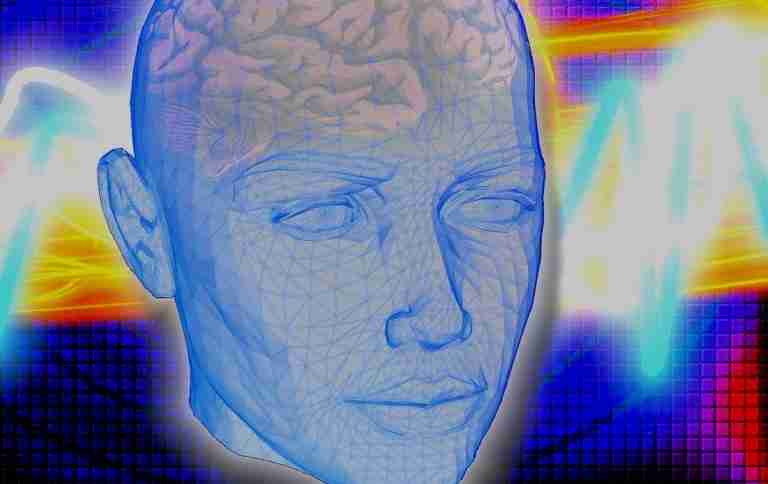After hours spent in the practice room are you still having trouble remembering the chord changes to a standard you endlessly practiced, or the details of a jazz line you drilled over and over? Why can’t you remember all this stuff, even after you’ve practiced it? Is the answer more practice, or might there be a better way??
We all seem to have been told somewhere along the line that practice makes perfect and that it’s simply a matter of putting in the time to get where we want to go.
And of course there’s truth in that – there’s simply no way around putting in a lot of practice at anything you want to get good at. However, jazz improvisation is a little different than other things…
You see, we need a skill set that lives inside our intuition, that’s accessible in an instant, ready-to-go with no preparation. Everything needs to be effortless.
But to get there it’s not just instrumental practice we need to focus on. We also need to cultivate the ability to practice in our head. We need BRAIN training.
Practicing in your head is essential for every jazz musician. It’s this brain training that will help you learn chord changes deeply, recall lines in all keys easily, and improvise with fluidity.
Our instrument is just a tool – an amplification of what’s inside us. The true music takes place in our mind.

Today we’ll take you through 3 different exercises that will help you learn some of the most important jazz concepts to practice in your head.
These are exercises you can take with you everywhere you go, making your commute, a wait in the dentist’s office, or any other part of your day a chance to practice jazz standards, language, and more…
And once you start practicing in your head and realize how effective it is, you’ll never want to stop!!
How to Practice visualizing jazz language step-by-step
Let’s start to practice in our head by understanding what it actually means to “visualize” when it comes to jazz improvisation…
Most of the time you probably think of visualization having to do with sight. I mean, the word literally is visualize, based upon the word visual which in general terms we might not equate to sound or touch.
But when we’re talking about jazz visualization, we’re talking about a lot more than sight…
When we visualize something in music, it should mentally replicate what it feels like to play it
Basically, you want to fool your mind…
You want your mind to think that you’re sitting there in the practice room, actually playing your instrument, going through the exact steps that you would go through to really play the material.
With visualization, your goal is to feel the sensation of what it would be like to play your instrument. Even though it’s called visualization, it encompasses the physical, the aural, and the emotional…
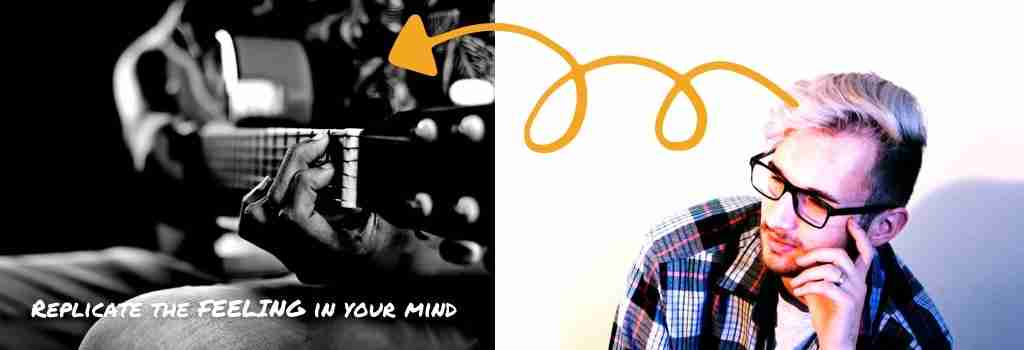
And that overall feeling is the most important part about visualization. Sure, it can be advantageous to mentally see the chord changes in your mind, or to see the written notation of a line in your head, but all of this is secondary to “feeling” the act of playing your instrument in your mind…
When you visualize, you mentally feel your fingers touch the keys and operate your instrument – there should be little to no distinction between mentally playing your instrument and actually playing your instrument.
And when this is achieved, you’re visualizing in an effective manner.
EXERCISE #1: Let’s practice visualizing jazz language…
With ANY line you transcribe from one of your heroes, you can easily take a piece of the line and create a visualization exercise that you can practice in your head.
Take a listen to the great Stan Getz on There Will Never Be Another You…His lines flow effortlessly, one naturally moving to the next.
Now, let’s say this solo caught your ear and you decided to transcribe some of it, or perhaps even just a few bars like this…

Next, we’ll take a small piece over the major chord and decipher the logic behind it so it’s easy to conceptualize.

What’s going on here? What kind of things can we think about to easily understand this piece of major language?
Here are a few things that you might want to think about…
- What beat it starts on – It starts on the “And” of beat one
- What note it starts on – The first note is the 5th of the chord
- Use of chromaticism – It descends chromatically down from the 5th
- Use of triads – It ascends using an inverted root triad
These are just a few elements to think about, but they should be enough to understand the underlying logic of the line.
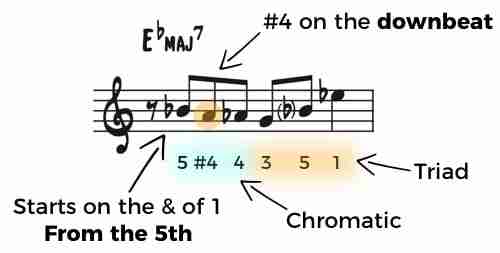
These are the details behind the line that will help you conceptualize it – by understanding these inner workings and labeling them, it will be easier to think through the line and mentally put it in all 12 keys.
Next, go get your instrument and close your eyes and play the line without looking at the music. Play it several times and really capture what it feels like to play the line.
If you’re having trouble, slowly walk through the logic of the line in your mind as you play it…think…
- Start on the and of 1…
- Play the 5th…
- Descend chromatically to the 3rd…
- Play up the inverted triad
Take it slow and realize this will be tricky at first even with such a small piece of a line. Don’t be fooled, it’s not easy…
Now, once you’ve played it perfectly, step away from your instrument, close your eyes, and mentally play the line in your head aiming to replicate exactly what it felt like to play it on your instrument.
Go back and forth between playing and visualizing until you can easily visualize exactly how it feels to play the line. And this can mean whatever visualizing means to you…whether that has more of an aural, visual, or tactile sensation…
For me, it’s a combination of all three, but it’s primarily the tactile sensation of playing my instrument in my mind, the feeling of pressing the keys and putting air through the horn…
Once you’ve accomplished this, move up a half-step and try to mentally play the line in your head in the new key…

If you have the logic of the line down and you can visualize it in the original key, then moving it up to a new key in your head shouldn’t be too difficult.
Again, if you’re having trouble, walk through the logic of the line in your mind as you play it…think…Start on the and of 1…play the 5th, descend chromatically to the 3rd….play up the inverted triad…
For all of this to happen fast, obviously these chord-tones and relationships all need to be burned into your brain through constant repetition.
In jazz improvisation and in everything else, there’s no way around “just knowing” certain information. So if you can’t quickly grab chord-tones, chords, and pieces of scales, you owe it to yourself to get busy visualizing.
For extra help and step-by-step instruction with all the fundamentals you could possibly hope for, make sure to check out our Jazz Visualization Course.
Ok, now keep moving up in half-steps until you’ve taken the line through all 12 keys.

THIS is what visualizing jazz language is all about – the more closely you can replicate what it feels like to play a line in your mind, the better your mental practice with jazz language will be…which will lead to nearly flawless physical execution!!
How to practice mentally hearing chord changes
Another crucial aspect of jazz improvisation to practice in your head is the way chords sound as they move from one to the next…
So much of the time we depend on external sources like play-alongs or a band to tell us what the chord changes of a tune actually sound like.
But as a jazz improviser, we need the ability to pre-hear where the chords are going…we need to be both proactive and reactive to give our melodic lines clear direction and meaning.
All of this is only possible if we can hear the chord changes in our mind…
So what does it mean to hear the chord changes in your mind??
Just like visualizing jazz language is all about mentally reproducing what it feels like to play it, hearing chord changes in your head is all about mentally reproducing the rhythm section playing the chords.
The goal is to hear the band perfectly playing the changes in your mind – it’s as if you have your own personal play-along track that lives in your head.
And this is not an easy feat…
It takes time and dedication to build up your aural awareness, chord vocabulary, and rhythmic understanding to construct an accurate aural image of the changes in your mind.
And on top of that, you have to start doing daily jazz ear training so your brain knows how to make sense of the sounds it’s hearing…
But with some practice, you’ll get closer and closer to being able to hear the changes in your mind, eventually being able to retain larger and larger chunks of music in your mind.
EXERCISE #2: Let’s practice hearing chord changes in your head…
Have a listen to Wynton Kelly playing There Will Never Be Another You.
We’re going to use his excellent comping along with the total sound of the rhythm section for this exercise.
Below are the first 9 bars of the form of the tune…

Now, I want you to listen to only the first 3 measures several times in a row and when you’re listening, I want you to focus on retaining the sounds of the chords in your mind…
So, aim to retain the sound of the Eb major 7 chord, the sound of the transition to the D-7b5, and the sound of the D-7b5 chord in your mind.
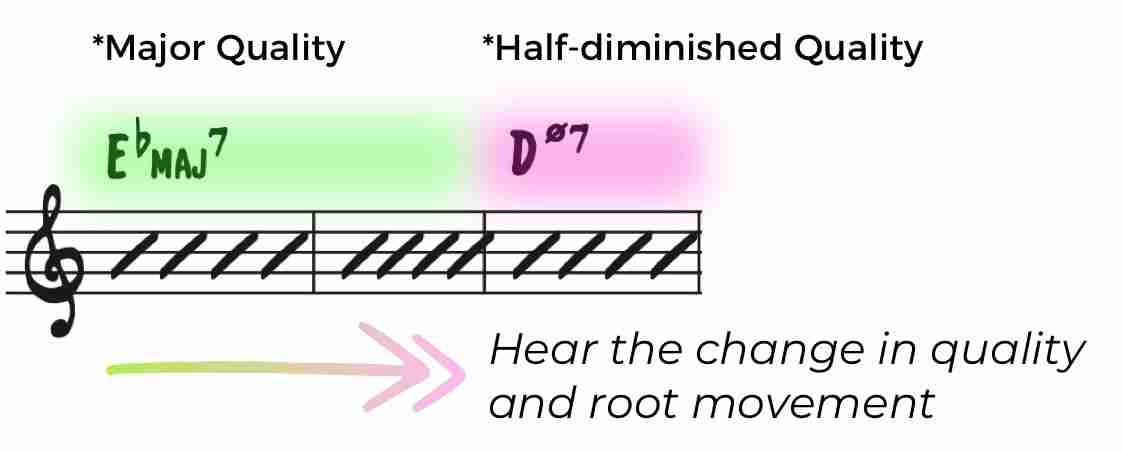
And then, after you’ve played the example a few times, turn your focus to the music in your mind and “replay” the first 3 bars in your mind.
Go back and forth between the audio sample and your mental music until you can confidently hear the first 3 bars of the tune in your mind as accurately as possible.
It’s very similar to drawing something that you’re looking at. You look at what you want to draw, retain the image in your mind’s eye, and then proceed to draw what you see in your mind. If you’ve ever tried this, it’s quite a challenge and takes time and study…
But with music, it’s sound – you listen to the progression, retain the audio in your mind’s ear, and then mentally replay the sound in your mind at will.
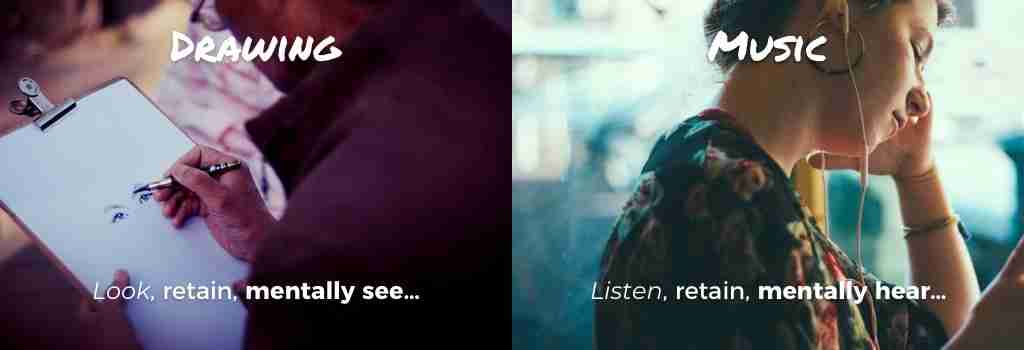
Ok, next listen to the first 6 bars of There will Never be Another You and do the same thing you did before…focus on the sounds of each chord and how each one progresses.

Try to replay the band in your mind for these 6 bars. Keep listening to the audio sample if you’re having trouble recalling it, going back and forth until you can easily replay the first 6 bars in your mind.
Make sure you’re continuing to hear the major quality, the half diminished quality, the transition from major to half diminished, and the minor ii V resolving to the Vi chord.
Next, listen to the first 7 bars…
Hear everything we worked on up to this point, but now add in the transition from the Vi minor chord to the minor chord down a whole step.

Then, try to replay the band in your mind for these 7 bars, going back and forth until you can easily replay the first 7 bars in your mind.
And finally, listen to the entire 9 bar section and aim to retain the whole section in your mind and mentally replay it.
Remember to continue to hear everything we’ve done so far, and this time, hear the ii V I resolving to the IV major chord

If this was difficult, don’t sweat it!! This exercise is pretty challenging. Use it as a learning experience to grasp what it means to truly hear the chord changes in your mind.
With practice it will get easier and easier to keep chord changes in your mind and take the whole band with you everywhere you go…
How to practice moving chord changes in your mind
Moving chord changes in your mind is the essential mental skill to play any jazz tune in any key…
Imagine the band changing keys or playing a jazz standard in a different key than usual and being able to easily conjure the chord changes without stressing about it.
That’s exactly what you’ll get if you learn to think through the logic of chord changes and move them in your mind.
Basically, this skill has two components:
- Understanding chord function
- Understanding bass movement
If you don’t know what chord function is then head over to this lesson on chord function for all the details. And if you’re really interested in mastering chord function, then make sure to check out our course Jazz Theory Unlocked…
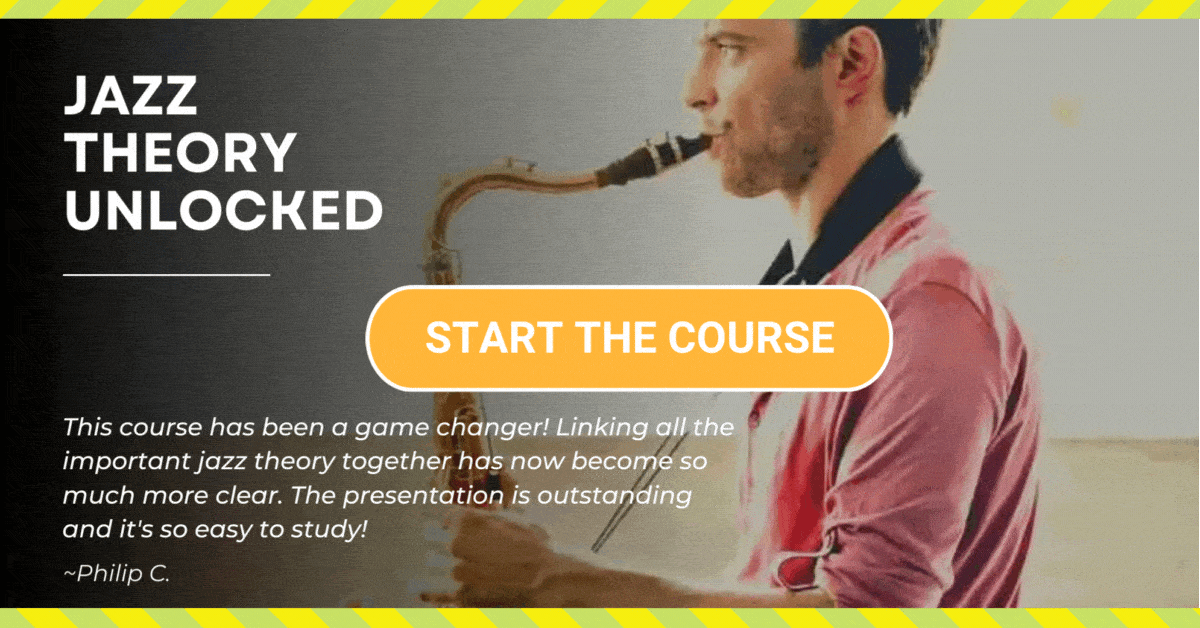
Knowing exactly how a chord is functioning within the context of the overall chord changes is crucial to being able to think through chord changes in all keys.
And understanding bass movement involves knowing your intervals and having some basic ear training under your belt.
Then, with these fundamentals at your disposal, you’ll then need to bring everything together and adopt a thinking process for moving changes in your mind.
The best way to learn this process is by just doing it, so let’s dive in…
EXERCISE #3: Let’s practice moving chord changes in your head…
Ok, here are the first 9 measures of There Will never Be Another You again…

Now, how are you going to think about these chords to make it easy to move them to another key in your mind?
Remember, the logic of chord changes is a combination of understanding:
- The chord functions, especially where each chord is headed and why
- The bass movement, focusing on the intervallic relationships between chords
Applying this thinking to the first 8 bars of There Will never Be Another You would give you something like this…

This underlying logic helps us understand and hear what’s happening in the chord changes so they are easy to think about.
When chord changes are easy for you to THINK through, then they are easy to PLAY through, and easy to transpose into any key
Think you got a grip on the logic behind the progression? Let’s try moving the chord changes to the key of Ab.
So, if it were in Ab…
We’d think down a half-step to start a minor ii V that’s going to travel to the relative minor…

Then, down a whole step from there to a ii V I in the key IV major…

See how easy it is when you’re thinking about the changes in the right way?
If a tune’s changes seem to be extra difficult to think through in your head, ask yourself:
- Do I actually know every chord in the chord changes?
- Do I know that the chord changes I learned are accurate?
- Do I understand how every chord is functioning?
- Do I understand the purpose of each chord and where it’s headed?
- Do I understand the bass movement and the intervallic relationships?
If you’re thinking about the wrong changes, you’re missing a change, or you don’t know why a chord is there or how it functions, it’s going to be a lot more difficult for you to think through the changes.
Find these spots, iron them out, and you’ll be able to think through any chord changes you desire, no matter how complex!
Start Your Brain Training Today
Visualization is everything.
If you can’t play something in your head, it’s going to be 10 times harder to play it on your instrument.
You play the way you think & hear
Remember, visualization is as personal and unique to an individual as the way each person hears or sees. There’s no one correct way to visualize or to play in your head, so don’t get too caught up in the idea of specific ways to “see” things in your mind, and instead focus on the feeling.
As I mentioned earlier, for me the most important aspect of visualization is the tactile element – feeling in your mind what it’s like to play. Work on this and you’ll see huge rewards.
For a complete guide on visualization, head over to our Visualization Course for Jazz Improvisation…

Practicing in your head is the key to speeding up your improvement…
And it might seem counterintuitive, but going straight to your instrument without first visualizing what you want to work on is not an efficient way to practice.
Pick up your instrument after you’ve visualized everything you want to accomplish, all the way from your sound & technique, to the actual lines & jazz standards you’re working on.
Physically practicing your instrument is the last step in the process…
And with all the time we have in a day where we’re waiting, commuting, exercising or just relaxing, you shouldn’t have to block out any extra specific visualization time…
Simply try one of the exercises we went over today during your bus ride to work, or your jog at the park…
- Practice mentally hearing chord changes
- Practice mentally playing language
- Practice moving changes in your mind
It’s time to speed up your progress and make use of all of your time outside of the practice room. Start practicing in your head today and open up a world of possibility!!
